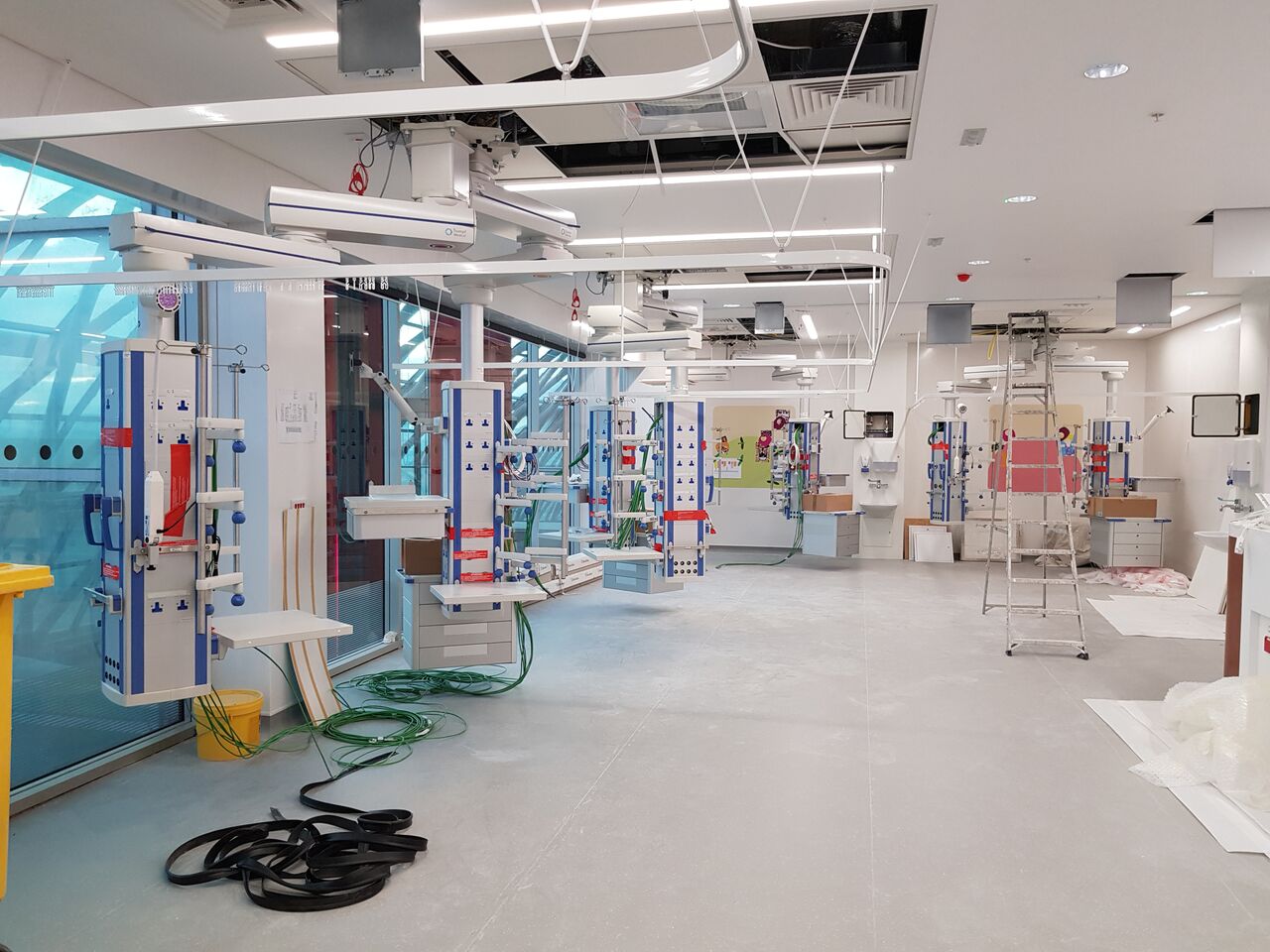Healthcare construction projects are by their nature very complicated, and some can take up to a decade to reach completion, with delivery delayed by many issues including facilitating changes to clinical care models needing to be accommodated as projects progress; working in live healthcare environments; and procurement, design and delivery processes that do not facilitate effective collaboration between all involved in a project.
But collaborative framework agreements and relationships are helping to address the above by enabling those involved to collaborate from the earliest stages of a project.
Over the past decade or so many construction frameworks have been established, many of which are available to the NHS.
In the NHS there has been a lack of capital in the system for years and an increasing issue with backlog maintenance which will require the NHS to collaborate with others including constructors and their supply chains to resolve
But, unarguably, one of the most successful of these has been the Department of Health and Social Care’s (DHSC) ProCure framework, which has gone from strength to strength since the advent of the initial ProCure21 framework for the delivery of design and construction services for the NHS across England in 2003.
It addressed the requirements of central government policy, including the productivity and efficiency agenda; the Government’s Construction Strategy; the Public Contracts Regulations 2015; and guidance on the use of centralised frameworks.
So successful has it proved that it has won a stream of awards including the Constructing Excellence South East – Integration and Collaborative Working Award 2015; the National Constructing Excellence Awards 2015 – Integration and Collaborative Working Award; and the British Construction Industry Awards 2015 - Product Design Innovation (Building).
Following the success of the original seven-year framework, ProCure21+ (P21+) was launched in 2010 and expired in 2016, succeeded by ProCure22 (P22), which is currently underway and will run until October 2020.
It is expected this will be followed by a successor that will build on the achievements of all three earlier iterations.
Since its launch P22 has continued to help streamline the procurement process and create an environment in which clients, principal supply chain partners (PSCPs), and their own supply chains can develop stronger partnerships to drive increased efficiency and productivity while at the same time supporting enhanced clinical outputs for patients and improved environments for patients, staff and visitors.
And all three iterations have also provided the NHS with the tools needed to deliver improved estates performance while lowering construction and maintenance costs, a vital benefit at a time when available capital is at an all-time low and backlog maintenance and refurbishment pressures are high.
P22 involves six PSCPs, all leading construction companies who work with architects and other specialists to deliver a number of projects.
Bam, Galliford Try, Integrated Health Projects, Interserve Construction, Graham Construction, and Kier Health between them deliver around £600m-£1billion worth of work every year.
Where some frameworks just exist to get around procurement law, there is little, if any, pro-active support provided to clients using them and little strategic collaboration to deliver improvements over the life of the frameworks. ProCure is somewhat unique in that it is a fully managed and supported framework
The partnerships benefit as the teams get used to working together, thus avoiding some of the issues experienced in traditional approaches to the procurement of healthcare facilities.
One of the key aspects is that of collaborative working at both project level with NHS clients and strategic level with DHSC , NHS clients, and others.
And, with the advent of Sustainability Transformation Partnerships – where NHS organisations and local councils come together to plan improvements to health and care across regions – capital is now being ringfenced, and it is anticipated that this may provide additional opportunities for those involved in the framework in the future, including the SMEs that are involved in the supply chains who actually deliver the works packages on site.
Speaking to BBH , Omar Jomeen, healthcare director and ProCure lead at Galliford Try, explains: “ProCure is probably the longest construction framework within government.
“Where some frameworks just exist to get around procurement law, there is little, if any, pro-active support provided to clients using them and little strategic collaboration to deliver improvements over the life of the frameworks.
“ProCure is somewhat unique in that it is a fully managed/supported framework.
“It enables effective collaboration at a strategic level, which also involves supply chain members to develop and implement improvements to processes and procedures.
“It’s a planned approach led by PSCPs which brings construction leads in early in the procurement process to help shape the scheme from the off.”
He adds: “One thing often forgotten about in traditional procurement is the construction delivery method.
“You might have a scheme that has been worked through for years, with a lot of money spent on the design. But then, when the construction partner is eventually brought in to construct a design prepared by others i.e. ‘building a design’ NOT ‘designing to build’; they may look at the plans and say ‘if we moved the building slightly to the left the clinical outcomes would be the same, but we could save on cost and improve the environment’.
“But, by this stage, these changes would be too costly and would disrupt the build.
The ProCure approach and associated collaboration will continue to help deliver the infrastructure that the NHS will require in the future , while at the same time continuing to lower costs and improve patient outcomes
“There may also be issues associated with the constructor having to work out how to build a design they have had no input to the development of.
“ProCure enables us to look at projects much more holistically and ensures a degree of cost certainty from the very-early stages.
“For the PSCPs the benefit is that our teams are used to working together and delivering healthcare projects. The teams fully understand the client’s business, what their clients want, and they know the sites as they often undertake multiple projects over a number of years.
“The client also benefits from this stability.
“It’s not massive profit margins, but, for us, it is a continuous programme of works.”
In fact, under the framework, clients are given guaranteed maximum price which only changes if the client accepts the need for the change and all risks have been identified and agreed prior to that agreement.
Over the ProCure21+ and ProCure22 framework terms work by the DHSC, the NHS, and the PSCPs and their supply chains has resulted in the identification of repeatable room designs, associated products/components, and construction methods .
Jomeen said: “This is something we have worked really hard on and it enables clients to choose something off the shelf.
“We have explored the very, very best clinical models for a variety of environments – including multi-bed bays, consultation and examination rooms, emergency departments, mental health bedrooms, and single rooms – and have put together working groups to explore how we can create standardised solutions for these. This is a truly cost-effective way to speedily deliver new healthcare projects.”
Standardised products are also helping with cost efficiency and delivery times as the PSCPs work with trusted suppliers, fixing the price of products and ensuring they are designed with the needs of the end users in mind and are available for use by projects outside the P22 framework.
Currently, standardised components/products cover everything from doorsets, fire smoke dampers, and flooring, to medical bedhead services, and paint. And there are more being added all the time.
“By all the PSCPs working together on this, it gives us a collective advantage,” said Jomeen.
In fact, this standardisation was thought to have saved more than £11.5m across P21+ and P22 projects up to June last year.
Benefits also include improved warranties, added value services such as free design reviews etc, and manufacturers are now working with NHS trusts and patients to develop products and associated services that improve patient outcomes.
“Through this standardisation work we are also building better relationships with suppliers and are driving innovation,” said Jomeen
ProCure enables us to look at projects much more holistically and ensures a degree of cost certainty from the very-early stages
Training provision is another key advantage of the ProCure approach, as free training is available to all involved in the framework and the P22 Training Academy provides both face-to-face and online training.
Jomeen concludes: “In the NHS there has been a lack of capital in the system for years and an increasing issue with backlog maintenance which will require the NHS to collaborate with others including constructors and their supply chains to resolve.
“With the advent of STPs we are seeing a growth in funding for capital investment and this will provide opportunities for those involved with the ProCure frameworks to help address the issue that the NHS needs to address in the future .
“The ProCure approach and associated collaboration will continue to help deliver the infrastructure that the NHS will require in the future , while at the same time continuing to lower costs and improve patient outcomes.”

Standardised rooms and products are helping to further enhance projects
P22 - The benefits at a glance
SPEED Access to advice and estate development expertise very quickly with PSCP appointment within a very-short timescale
COST CERTAINTY The ability to control cost and get cost certainty by agreement to a Guaranteed Maximum Price
QUALITY Close integration of the supply chain and client ensuring agreed quality standards are achieved
VALUE Agreed rates and profit and overheads set at framework level. Savings generated from package re-tendering after agreed Guaranteed Maximum Price are returned 100% to the client, assuming no specification changes. Free VAT recovery service. Free training to NHS and social care clients
RESOURCE The ability to use various funding methods to support the development of a scheme
SUPPORTED Free support from the Department of Health from a dedicated team of Implementation Advisors (IA); also including free training, guidance documentation, template contracts and other tools. The IA will have an ongoing monitoring role to ensure project success
ASSURED PSCPs and supply chains are pre-vetted on appointment to framework which complies with current government standards for construction procurement
STRATEGIC NHS clients can align the delivery of their estate strategies with their ProCure work and so create relationships with suppliers. As and when a project is initiated by a client, a supply chain is already on site to provide feasibility, planning, costing and design advice. The client does not provide a long-term guarantee of work, but approves work to be as and when they need to, when funding is available, and if they are content their PSCP is performing well. This arrangement is compliant with the Public Contract Regulations and provides maximum flexibility for clients



